
In botany, a seed is a plant embryo and food reserve enclosed in a protective outer covering called a seed coat (testa). More generally, the term "seed" means anything that can be sown, which may include seed and husk or tuber. Seeds are the product of the ripened ovule, after the embryo sac is fertilized by sperm from pollen, forming a zygote. The embryo within a seed develops from the zygote and grows within the mother plant to a certain size before growth is halted.

Maror are the bitter herbs eaten at the Passover Seder in keeping with the biblical commandment "with bitter herbs they shall eat it.". The Maror is one of the symbolic foods placed on the Passover Seder plate.
Seed dormancy is an evolutionary adaptation that prevents seeds from germinating during unsuitable ecological conditions that would typically lead to a low probability of seedling survival. Dormant seeds do not germinate in a specified period of time under a combination of environmental factors that are normally conducive to the germination of non-dormant seeds.

Chaerophyllum is a genus of flowering plant in the family Apiaceae, with 35 species native to Europe, Asia, North America, and northern Africa. It includes the cultivated root vegetable Chaerophyllum bulbosum.
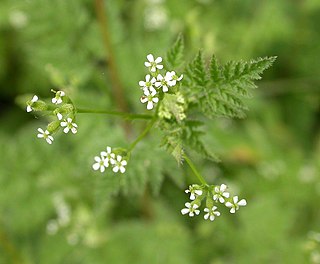
Anthriscus caucalis, also burr chervil or bur-chervil, a plant in the family Apiaceae. It is similar in appearance to chervil, the common cooking herb from the same genus. It sends up thin, hollow stems and bears umbels of white flowers. The light green leaves are triangular and made up of many leaflets. The tiny hard fruits, each about 3 millimeters long, are covered in hooked spines. The plant is native to and common in parts of Europe and Asia, and has been introduced elsewhere such as North America.
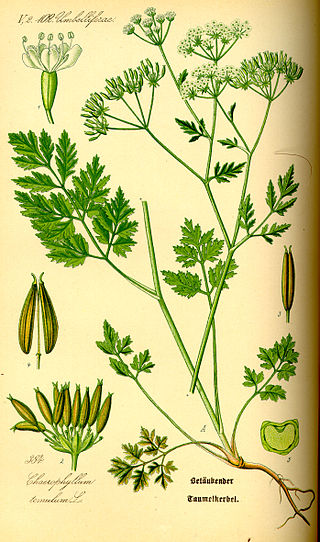
Chaerophyllum temulum, the rough chervil, is a species of flowering plant in the family Apiaceae.
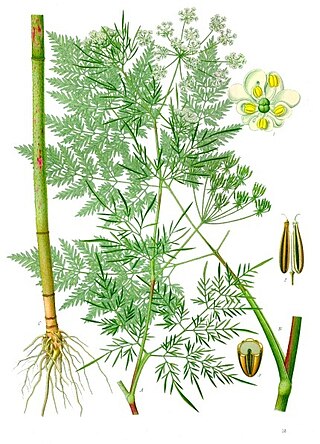
Chaerophyllum bulbosum is a species of flowering plant from the carrot family and known by several common names, including turnip-rooted chervil, tuberous-rooted chervil, bulbous chervil, and parsnip chervil. It is native to Europe and Western Asia. It was a popular vegetable in the 19th century.
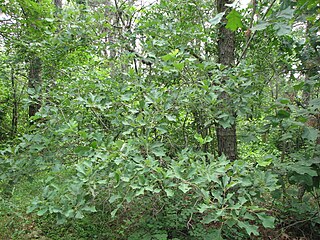
Quercus ilicifolia, commonly known as bear oak or scrub oak, is a small shrubby oak native to the Eastern United States and, less commonly, in southeastern Canada. Its range in the United States extends from Maine to North Carolina, with reports of a few populations north of the international frontier in Ontario. The name ilicifolia means "holly-leaved."

Torilis japonica, the erect hedgeparsley, upright hedge-parsley or Japanese hedge parsley, is a herbaceous flowering plant species in the celery family Apiaceae. Japanese hedge parsley is considered both an annual and biennial plant depending on the biogeographical location. This means Japanese hedge parsley can complete its life cycle in either one or two growing seasons depending on habitat. Japanese hedge parsley is typically found in areas with disturbed soils, pastures, margins, open woodland, near waste sites, or right-of-way habitats. It can withstand a variety of habitats, thriving in partial and full shaded areas, but also withstanding habitats with full sunlight penetration. It is considered an aggressive invasive species in North America; invading a wide range of habitats due to its environmental tolerance and tendency to outcompete native vegetation. This species is considered a threat in several areas that causes problems relating to overall environmental health and stability. Aside from its environmental implications, T. japonica has potential to fight several cancers through a terpene it produces called Torilin, extracted from its fruits.

Silene spaldingii is a rare species of flowering plant in the family Caryophyllaceae known by the common names Spalding's silene, Spalding's catchfly and Spalding's campion. It is native to eastern Washington, eastern Oregon, northern Idaho and northern Montana, where its distribution extends just into British Columbia, Canada. Much of its former habitat has been converted to agriculture and its range is now limited to the last remaining stretches of pristine prairie grassland in this region. It is threatened by the degradation and loss of its remaining habitat. It is federally listed as a threatened species in the United States and it is designated endangered by Canada's COSEWIC.

Frasera caroliniensis, commonly known as American columbo or yellow gentian, is a herbaceous perennial of the gentian family Gentianaceae found in the deciduous forest of Southern Ontario and throughout the eastern and southeastern United States. It was previously known as Swertia caroliniensis.

Epermenia chaerophyllella, also known as the garden lance-wing, is a moth of the family Epermeniidae first described by Johann August Ephraim Goeze in 1783. It is found in all of Europe and Asia Minor.

Paysonia stonensis is a species of flowering plant in the family Brassicaceae, known by the common name Stones River bladderpod. It is endemic to Tennessee in the United States, where it is limited to Rutherford County. It grows only in the floodplains of the Stones River, and certain tributaries.

Synandra is a monotypic genus of flowering plants in the mint family containing the single species Synandra hispidula, which is known by the common name Guyandotte beauty. It is native to the east-central United States where it ranges from southern Illinois to western North Carolina and Virginia.

Rhexia mariana is a species of flowering plant in the Melastomataceae family known by the common names pale meadow beauty or Maryland meadowbeauty. It is native to the eastern and lower midwestern United States.

Phaulernis dentella is a moth of the family Epermeniidae found in Asia and Europe. The moth was first described by Philipp Christoph Zeller in 1839.
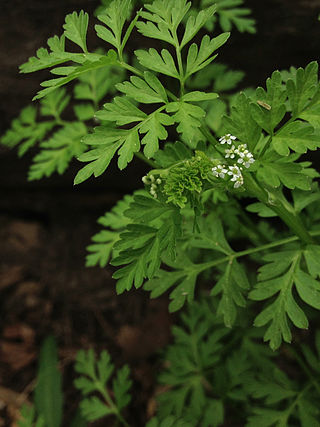
Chaerophyllum procumbens, known by the common names spreading chervil and wild chervil, is an annual forb native to the eastern United States and Canada, which produces small white flowers in spring.

Penstemon tenuiflorus, commonly known as eastern whiteflower beardtongue, is a species of flowering plant in the plantain family. It is native only to a small area of the Southeastern United States, in the southern Interior Low Plateau and Black Belt of Alabama and Mississippi. Its preferred habitat is limestone glades and woodlands.

Perideridia americana is a species of flowering plant in the family Apiaceae known by the common names eastern yampah and wild dill. It has been found in 12 Midwestern United States, and is listed as threatened or endangered in at least 3 of them. In Missouri it is a conservation species of concern.
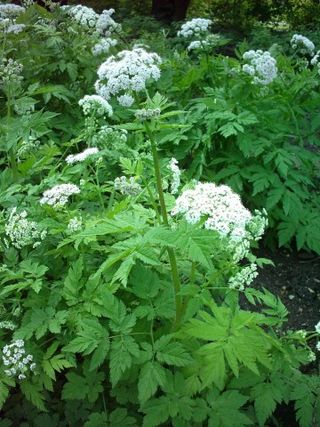
Chaerophyllum hirsutum, hairy chervil, is a species of flowering plant belonging to the parsley family Apiaceae.



















